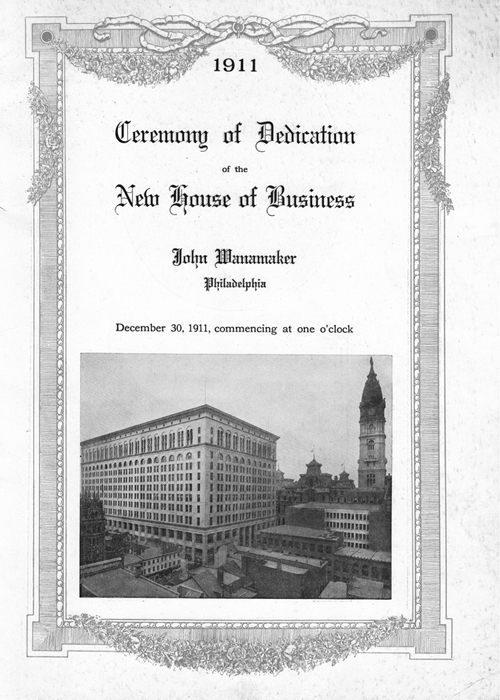
I remember going into the Philadelphia store for the first time and just feeling “Wow, this is where it started.” Everybody kept saying that “everybody meets at the Eagle” and thought “isn’t that cool?”
—Pat Ciarrocchi, news anchor, KYW-TV
After almost ten years of construction, John Wanamaker opened his new Philadelphia store in the summer of 1911. The opening of the impressive structure was the perfect way to celebrate the company’s fiftieth anniversary. The store was built in three sections. In April 1904, work began on the first section at Market and Juniper Streets. The final section to be completed was along Chestnut Street. But it was the second section of the construction that captured people’s attention and inspiration. The center of the store contained a Grand Court that soared six stories in the air.
The store’s famous architect, Daniel Burnham, was proud of his new building. “The building as a whole, both inside and outside, is the most monumental commercial structure erected anywhere in the world,” said Burnham.15 Its granite exterior and marble interior contained 1,019,854 square feet of selling area. The new Wanamaker store was spread over fourteen floors, ten of which were devoted to selling space. Back in 1902, Wanamaker had instructed Burnham that the store should be “simple, unpretentious, noble, classic—a work of art and, humanly speaking a monument for all time.”
On December 30, 1911, Wanamaker’s became the first retail store to be dedicated by an American president. Wanamaker had remained faithful and active in the Republican Party and supported William Howard Taft with his bid for the presidency. Taft returned the favor. He came to Philadelphia where he congratulated Wanamaker on his success.

The official program cover for the dedication of the new Wanamaker’s store in Philadelphia. Courtesy of the author.
Taft addressed the crowd and said:
I congratulate Mr. Wanamaker that he has been spared in his long and active life until this moment, when he can look around and see, in all its inspiring whole this enduring monument to the clear-sightedness and genius of his business career.
Taft also praised the burgeoning department store industry as “one of the most important instrumentalities in modern life for the promotion of comfort among people.” After dedicating the store, he visited a local newspaper and Independence Hall, where he rang the Liberty Bell by using his knuckles.
In the middle of the Grand Court stood a 2,500-pound bronze eagle that had been on display at the 1904 St. Louis Exposition. Wanamaker purchased the eagle for $10,000. The floor of the Grand Court was reinforced with a special girder in order to prevent sagging. The eagle contained 6,600 bronze feathers, each one hand-assembled by craftsmen employed from Frankfort, Germany. It wasn’t long before the Wanamaker Eagle became one of the country’s most famous trysting places.16
With the introduction of the Eagle at the Philadelphia store, every subsequent Wanamaker store always had a large sculpture of an eagle to call its own. Not only was it a symbol of Wanamaker’s, the Eagle also became part of Philadelphia’s identity. But the Eagle was not the only souvenir that Wanamaker purchased from the St. Louis Exposition. Perhaps the greatest piece of art in Philadelphia was installed right in his own Grand Court.